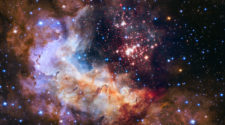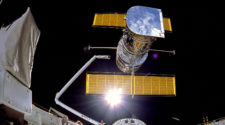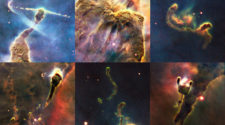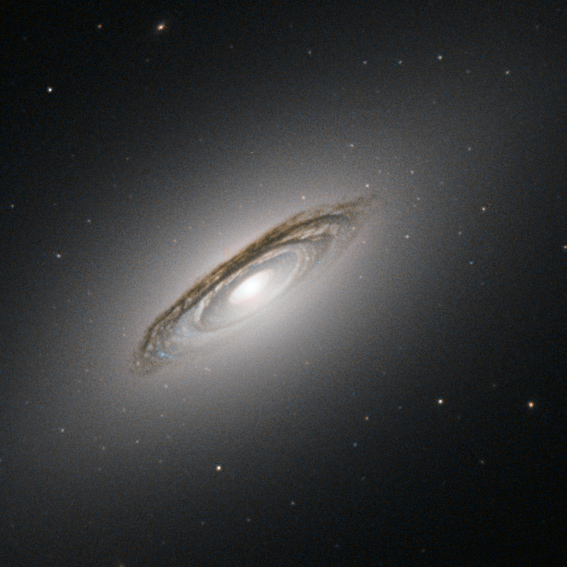
81. The third way of galaxies
The subject of this image is NGC 6861, a galaxy discovered in 1826 by the Scottish astronomer James Dunlop. Almost two centuries later we now know that NGC 6861 is the second brightest member of a group of at least a dozen galaxies called the Telescopium Group.
This view shows some important details of NGC 6861. One of the most prominent features is the disc of dark bands circling the centre of the galaxy. These dust lanes are a result of large clouds of dust particles obscuring the light emitted by the stars behind them.
Dust lanes are very useful for working out whether we are seeing the galaxy disc edge-on, face-on or, as is the case for NGC 6861, somewhat in the middle. Dust lanes like these are typical of a spiral galaxy. The dust lanes are embedded in a white oval shape, which is made up of huge numbers of stars orbiting the centre of the galaxy. This oval is, rather puzzlingly, typical of an elliptical galaxy.
So which is it — spiral or elliptical? The answer is neither! NGC 6861 does not belong to either the spiral or the elliptical family of galaxies. It is a lenticular galaxy, a family which has features of both.
The relationships between these three kinds of galaxies are not yet well understood. A lenticular galaxy could be a faded spiral that has run out of gas and lost its arms, or the result of two galaxies merging.
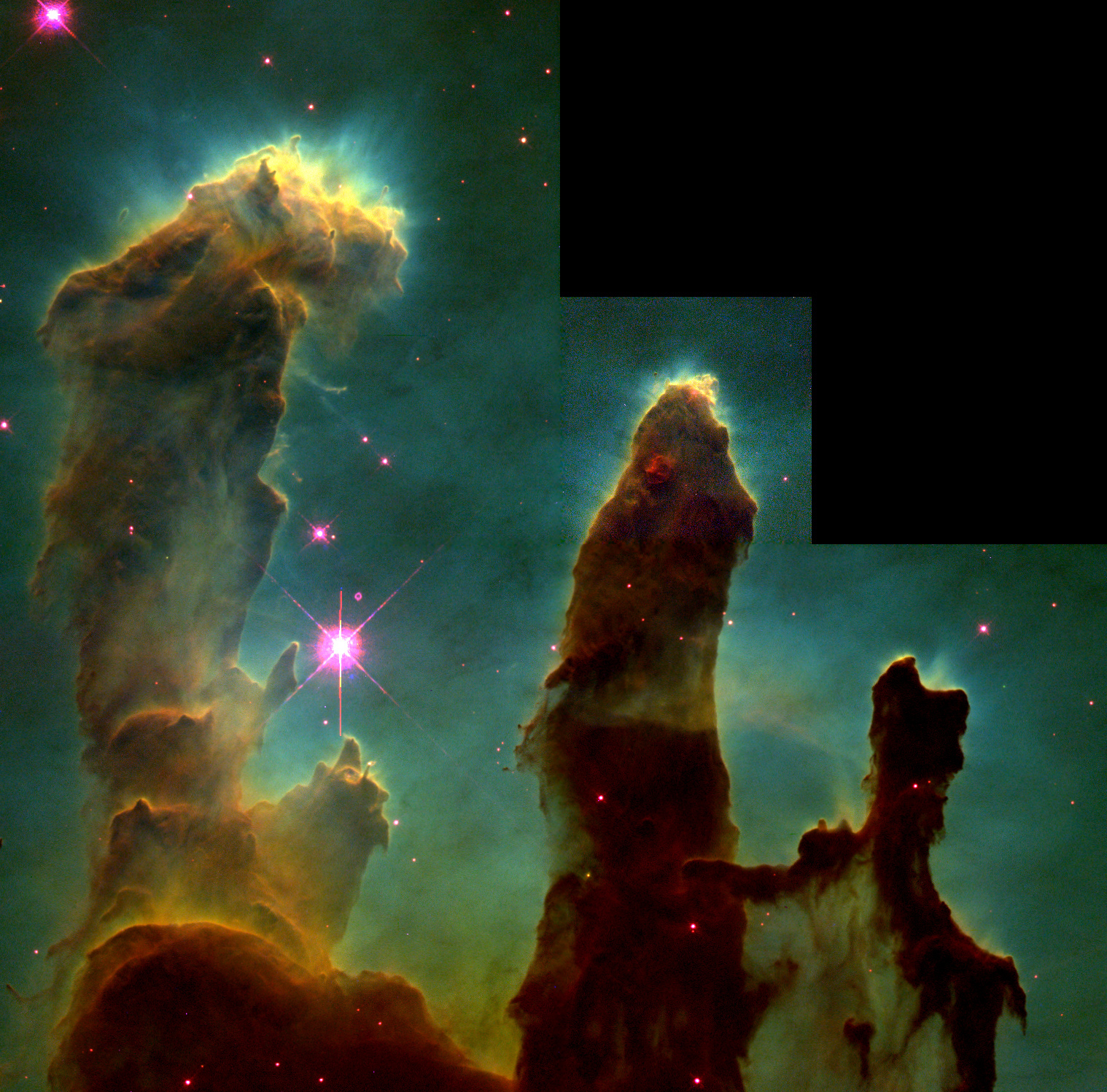
82. Pillars of Creation
These columns that resemble stalagmites protruding from the floor of a cavern columns are in fact cool interstellar hydrogen gas and dust that act as incubators for new stars. Inside them and on their surface astronomers have found knots or globules of denser gas. These are called EGGs (acronym for “Evaporating Gaseous Globules”). Inside at least some of the EGGs stars being formed.
Undersea coral? Enchanted castles? Space serpents? These eerie, dark pillar-like structures are actually columns of cool interstellar hydrogen gas and dust that are also incubators for new stars. The pillars protrude from the interior wall of a dark molecular cloud like stalagmites from the floor of a cavern.
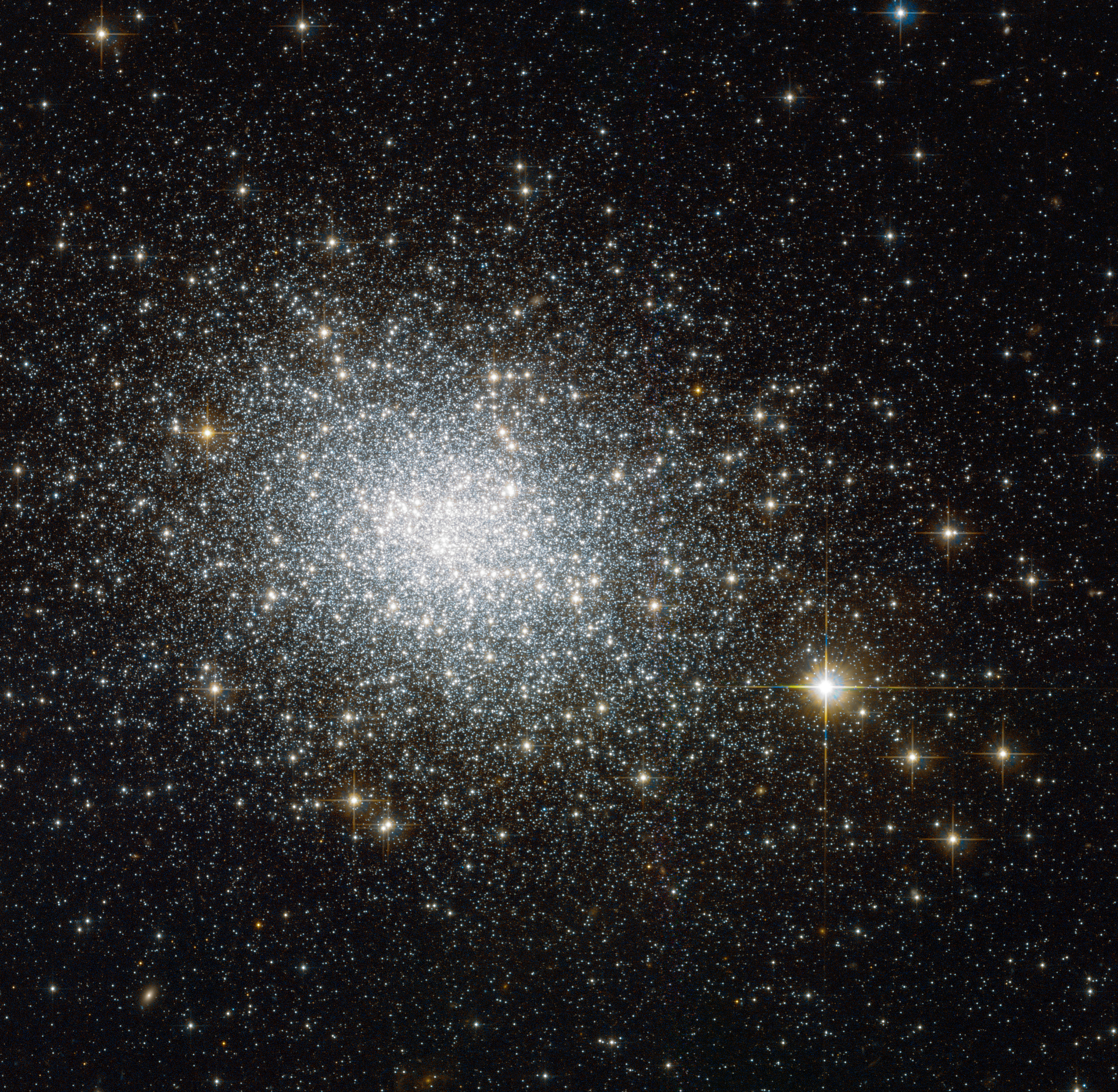
83. The oldest cluster in its cloud
This image shows NGC 121, a globular cluster in the constellation of Tucana (The Toucan). Globular clusters are big balls of old stars that orbit the centres of their galaxies like satellites — the Milky Way, for example, has around 150.
NGC 121 belongs to one of our neighbouring galaxies, the Small Magellanic Cloud (SMC). It was discovered in 1835 by English astronomer John Herschel, and in recent years it has been studied in detail by astronomers wishing to learn more about how stars form and evolve.
Stars do not live forever — they develop differently depending on their original mass. In many clusters, all the stars seem to have formed at the same time, although in others we see distinct populations of stars that are different ages. By studying old stellar populations in globular clusters, astronomers can effectively use them as tracers for the stellar population of their host galaxies. With an object like NGC 121, which lies close to the Milky Way, Hubble is able to resolve individual stars and get a very detailed insight.
NGC 121 is around 10 billion years old, making it the oldest cluster in its galaxy; all of the SMC’s other globular clusters are 8 billion years old or younger. However, NGC 121 is still several billions of years younger than its counterparts in the Milky Way and in other nearby galaxies like the Large Magellanic Cloud. The reason for this age gap is not completely clear, but it could indicate that cluster formation was initially delayed for some reason in the SMC, or that NGC 121 is the sole survivor of an older group of star clusters.
This image was taken using Hubble’s Advanced Camera for Surveys (ACS). A version of this image was submitted to the Hubble’s Hidden Treasures image processing competition by contestant Stefano Campani.
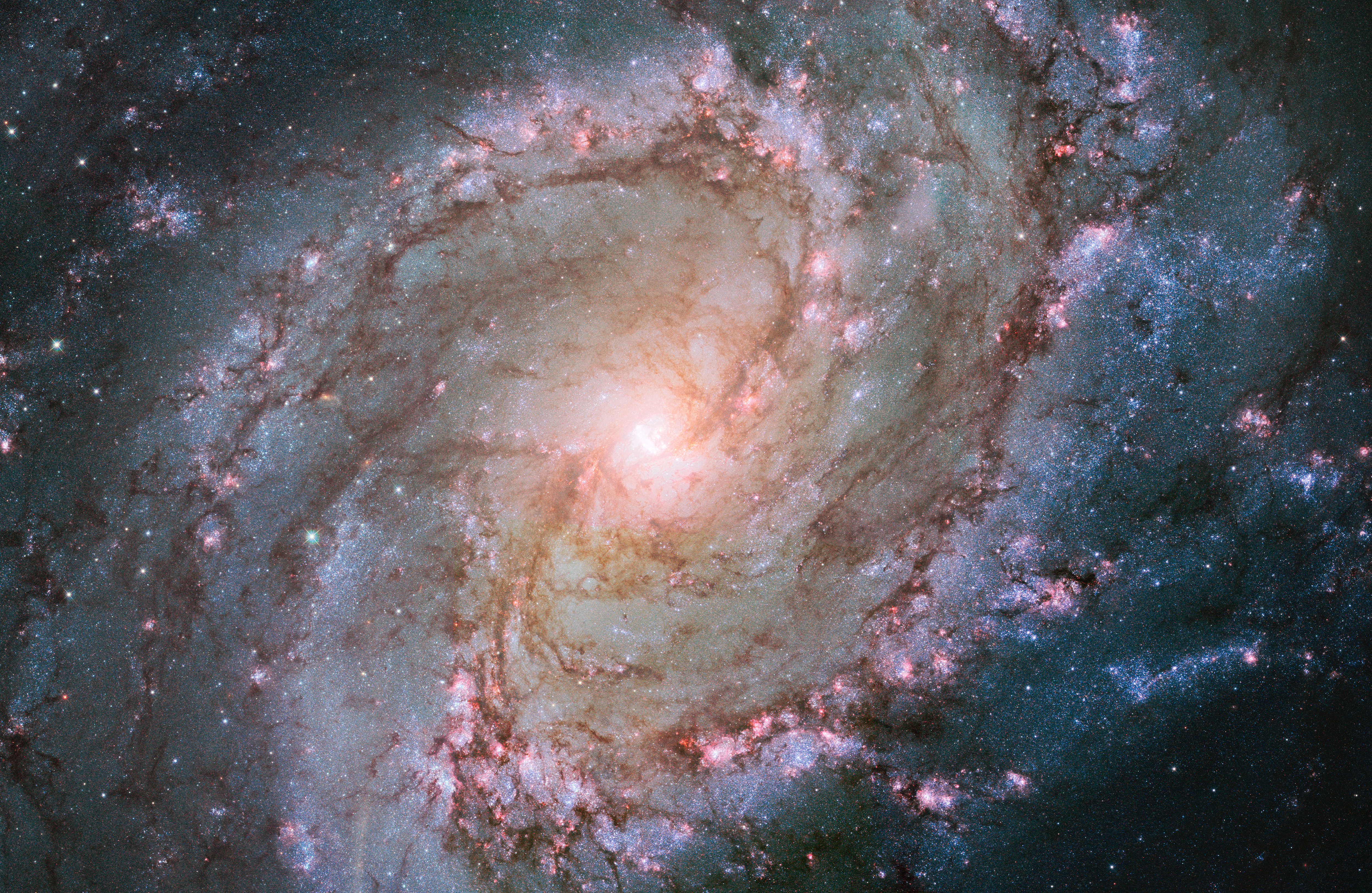
84. Barred spiral galaxy Messier 83
This new Hubble image shows the scatterings of bright stars and thick dust that make up spiral galaxy Messier 83, otherwise known as the Southern Pinwheel Galaxy. One of the largest and closest barred spirals to us, this galaxy is dramatic and mysterious; it has hosted a large number of supernova explosions, and appears to have a double nucleus lurking at its core.
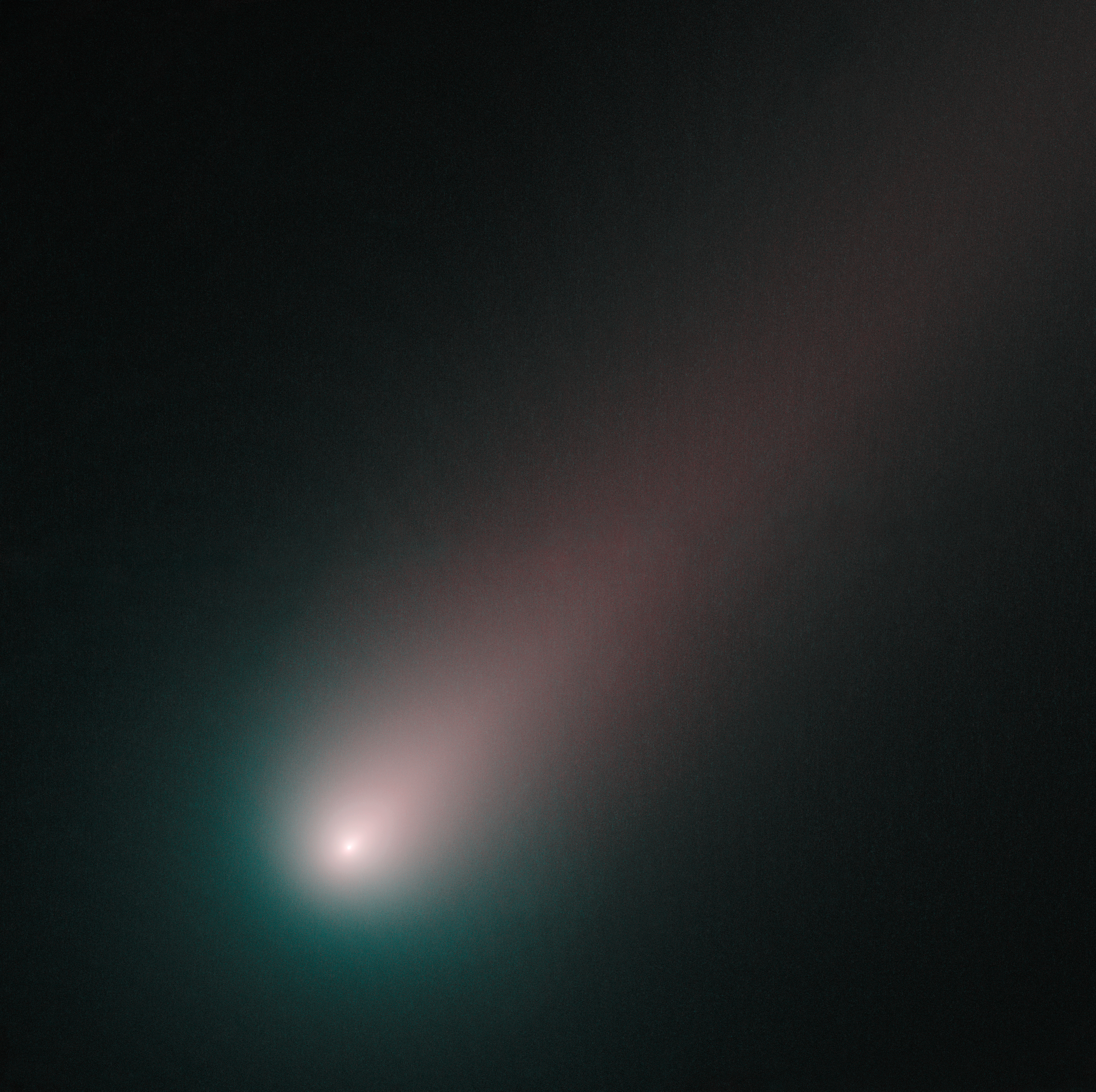
85. Hubble’s last look at ISON before perihelion
Here Hubble has taken its closest look at the innermost region of the ISON comet, where geysers of sublimating ice are fueling a spectacular tail.
Made from observations on November 2, 2013, the round coma around ISON’s nucleus is blue and the tail has a redder hue. Ice and gas in the coma reflect blue light from the Sun, while dust grains in the tail reflect more red light than blue light. This is the most colour separation seen so far in ISON and the comet, nearer than ever to the Sun, is brighter and more structured than ever before.
Comet ISON came closest to the Sun on November 28, a point in its orbit known as perihelion. Comet ISON was fairly quiet until November 1, when it experienced an outburst that doubled the amount of gas the comet emitted. After this image was taken, a second outburst shook the comet, increasing its activity by a factor of ten.
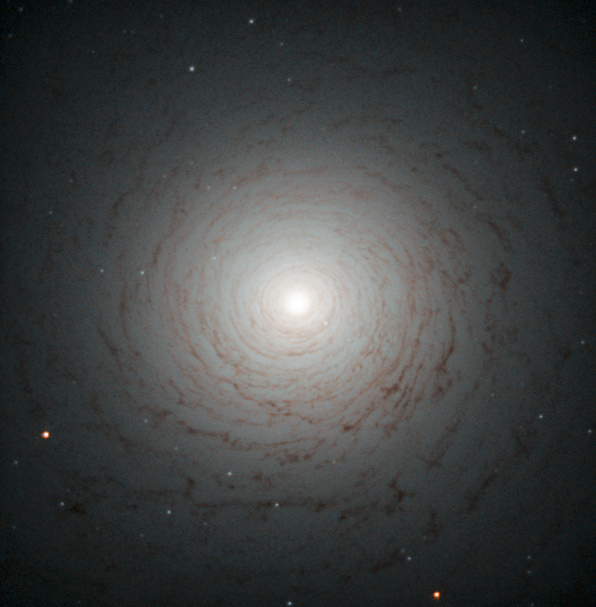
86. Mysterious old spiral
This striking cosmic whirl is the centre of galaxy NGC 524, located in the constellation of Pisces, some 90 million light-years from Earth.
NGC 524 is a lenticular galaxy. Lenticular galaxies are believed to be an intermediate state in galactic evolution — they are neither elliptical nor spiral. Spirals are middle-aged galaxies with vast, pinwheeling arms that contain millions of stars. Along with these stars are large clouds of gas and dust that, when dense enough, are the nurseries where new stars are born. When all the gas is either depleted or lost into space, the arms gradually fade away and the spiral shape begins to weaken. At the end of this process, what remains is a lenticular galaxy — a bright disc full of old, red stars surrounded by what little gas and dust the galaxy has managed to cling on to.
This image shows the shape of NGC 524 in detail, formed by the remaining gas surrounding the galaxy’s central bulge. Observations of this galaxy have revealed that it maintains some spiral-like motion, explaining its intricate structure.
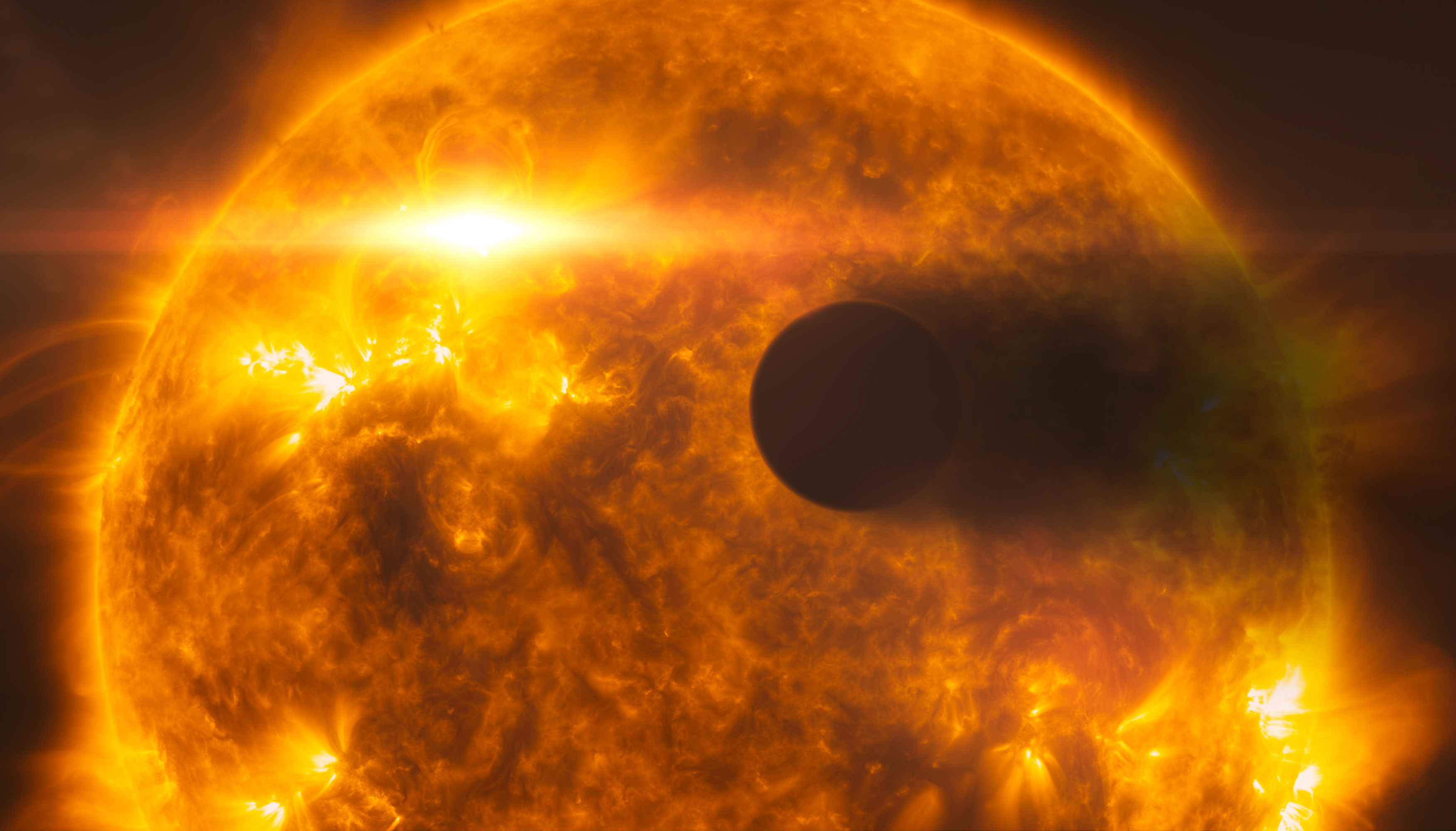
87. Stellar flare hits HD 189733b (artist’s impression)
This artist’s impression shows exoplanet HD 189733b, as it passes in front of its parent star, called HD 189733A. Hubble’s instruments observed the system in 2010, and in 2011 following a large flare from the star (depicted in the image). Following the flare, Hubble observed the planet’s atmosphere evaporating at a rate of over 1000 tonnes per second.
In this picture, the surface of the star, which is around 80% the mass of the Sun, is based on observations of the Sun from the Solar Dynamics Observatory.
“I study the atmospheres of planets orbiting nearby stars (also known as exoplanets), and it’s safe to say that this field is completely dominated by space telescopes, including both Hubble and Spitzer.
“Thirteen years ago Hubble was the first telescope to detect the atmosphere of an extrasolar planet, and today we are using the same techniques to study the atmospheres of an entirely new class of planets known as ‘super-Earths.’ These worlds have masses between 1-10 times that of the Earth and compositions ranging from dense rock to puffy, hydrogen- or water-rich ‘mini-Neptunes’. They are the most common kind of extrasolar planet found in our surveys of nearby stars, yet we don’t have one in our own solar system. By studying the atmospheres of these planets we can gain important clues that will help us to understand their mysterious origins.”
Dr. Heather Knutson
Assistant Professor of Planetary Science
California Institute of Technology
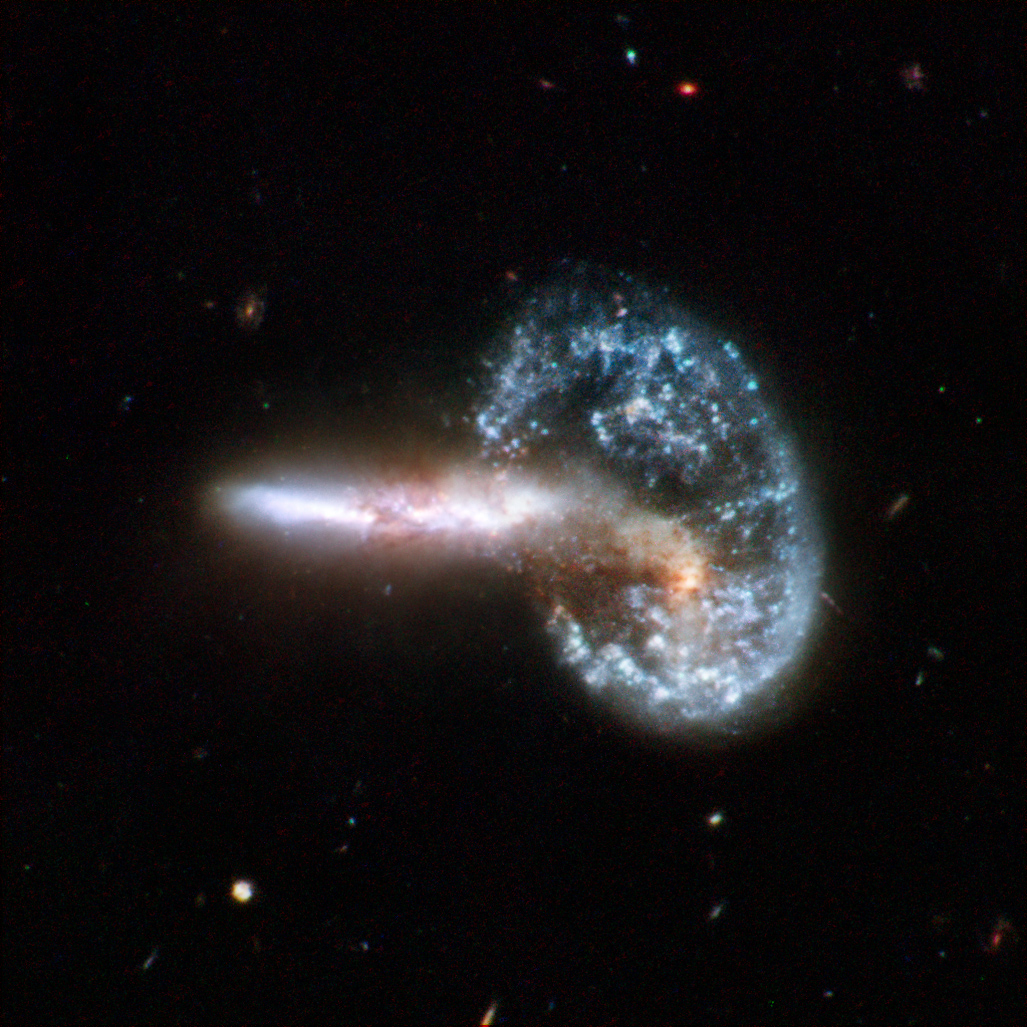
88. Arp 148
Arp 148 is the staggering aftermath of an encounter between two galaxies, resulting in a ring-shaped galaxy and a long-tailed companion. The collision between the two parent galaxies produced a shockwave effect that first drew matter into the centre and then caused it to propagate outwards in a ring. The elongated companion perpendicular to the ring suggests that Arp 148 is a unique snapshot of an ongoing collision. Infrared observations reveal a strong obscuration region that appears as a dark dust lane across the nucleus in optical light.
This image is part of a large collection of 59 images of merging galaxies taken by the Hubble Space Telescope and released on the occasion of its 18th anniversary on 24th April 2008.
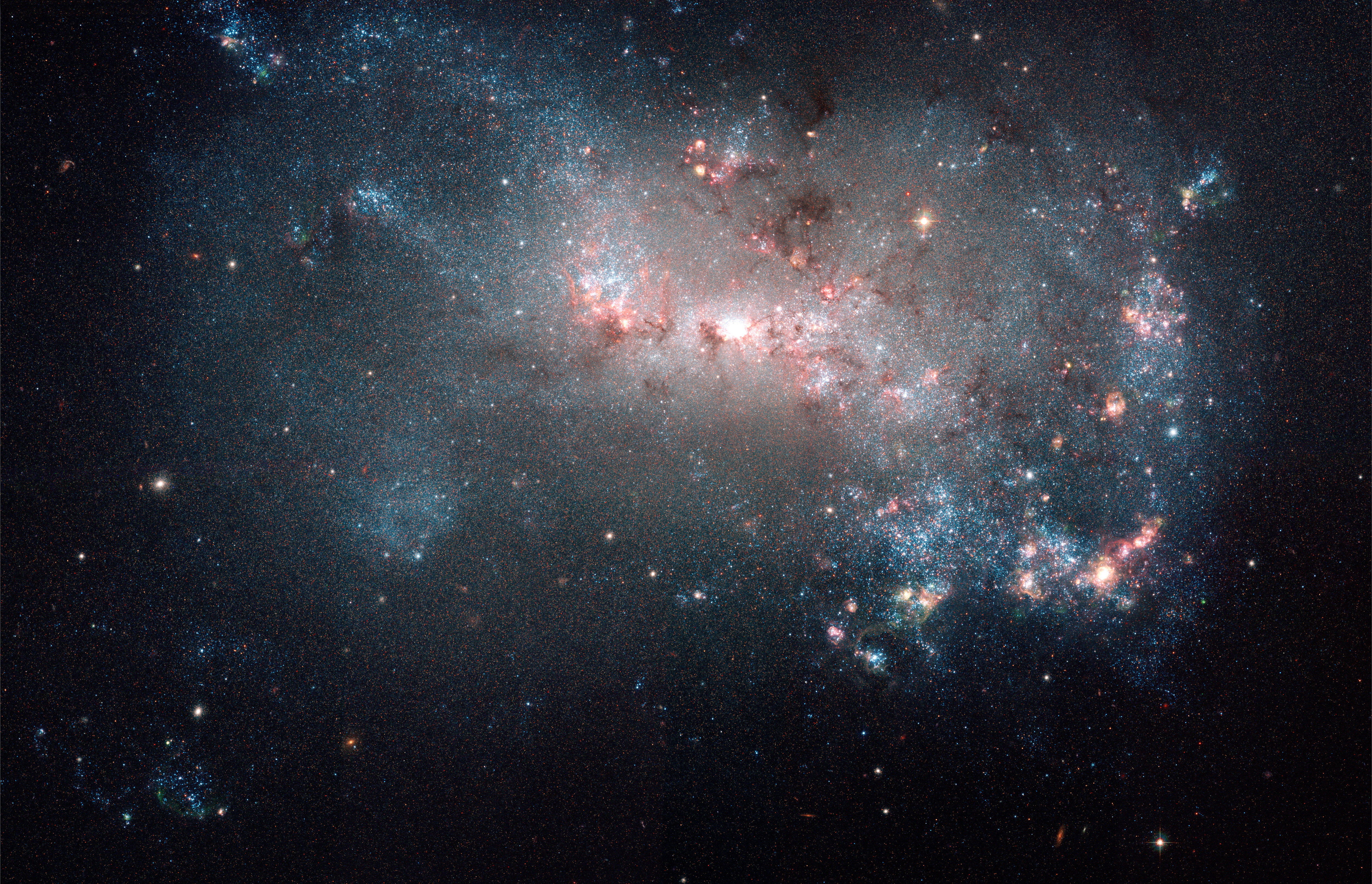
89. Stellar fireworks ablaze in NGC 4449
Hundreds of thousands of vibrant blue and red stars are visible in this image of galaxy NGC 4449. Hot bluish white clusters of massive stars are scattered throughout the galaxy, interspersed with numerous dustier reddish regions of current star formation. Massive dark clouds of gas and dust are silhouetted against the flaming starlight.
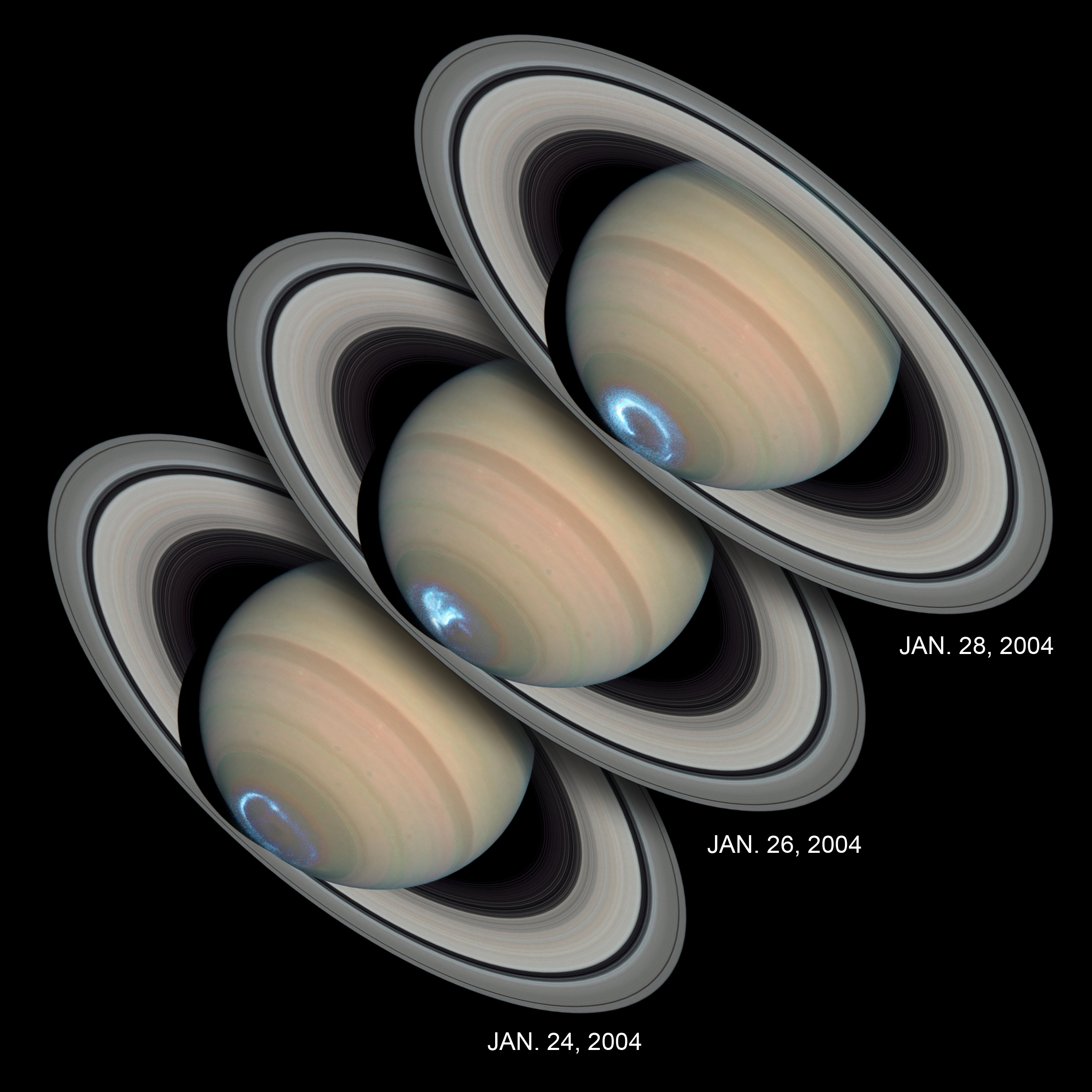
90. Saturn’s dynamic aurorae
These images reveal the dynamic nature of Saturn’s aurorae. Viewing the planet’s southern polar region for several days, Hubble snapped a series of photographs of the aurora dancing in the sky. The snapshots show that Saturn’s aurorae differ in character from day to day, as they do on Earth, moving around on some days and remaining stationary on others. But compared with Earth, where auroral storms develop in about 10 minutes and may last for a few hours, Saturn’s auroral displays always appear bright and may last for several days.
The observations, made by Hubble and the Cassini spacecraft, while en route to the planet, suggest that Saturn’s auroral storms are driven mainly by the pressure of the solar wind – a stream of charged particles from the Sun – rather than by the Sun’s magnetic field.
The aurora’s strong brightening on Jan. 28, 2004 corresponds with the recent arrival of a large disturbance in the solar wind. The image shows that when Saturn’s auroras become brighter (and thus more powerful), the ring of light encircling the pole shrinks in diameter.
Seen from space, an aurora appears as a ring of glowing gases circling a planet’s polar region. Auroral displays are initiated when charged particles in space collide with a planet’s magnetic field. The charged particles are accelerated to high energies and stream into the upper atmosphere. Collisions with the gases in the planet’s atmosphere produce flashes of glowing energy in the form of visible, ultraviolet, and infrared light.
Astronomers combined ultraviolet images of Saturn’s southern polar region with visible-light images of the planet and its rings to make this picture. The auroral display appears blue because of the glow of ultraviolet light. In reality, the aurora would appear red to an observer at Saturn because of the presence of glowing hydrogen in the atmosphere. On Earth, charged particles from the Sun collide with nitrogen and oxygen in the upper atmosphere, creating auroral displays colored mostly green and blue.
The ultraviolet images were taken on Jan. 24, 26, and 28, 2004 by Hubble’s Space Telescope Imaging Spectrograph. Erich Karkoschka of the University of Arizona, USA used the telescope’s Advanced Camera for Surveys on March 22, 2004 to take the visible-light images.
“Hubble has been a pivotal observatory in my work. One of my first projects involved processing early images from before Hubble’s corrective optics were installed, and I have been involved in observing the outer planets ever since.
“Hubble images have been used in most of my scientific projects, and have provided a long-term record of the atmospheres of those planets. Given the very long orbits in the outer solar system, having a record over decades is critical to understanding their atmospheric processes.”
Dr. Amy A. Simon
Senior Scientist for Planetary Atmospheres
NASA Goddard Space Flight Center
Greenbelt, Maryland

